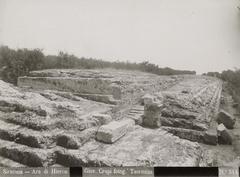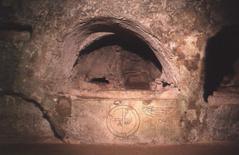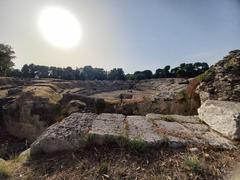
Arethusa Spring Visiting Hours, Tickets, and Historical Information in Syracuse, Italy
Date: 17/07/2024
Introduction
Arethusa Spring, nestled on the picturesque island of Ortygia in Syracuse, Italy, is a site of profound historical, cultural, and environmental significance. This captivating spring, with its roots deeply embedded in ancient Greek mythology, continues to enchant visitors from around the globe. According to legend, Arethusa was a nymph who transformed into a spring to escape the river god Alpheus, a tale that has been interwoven into the cultural fabric of Syracuse for centuries (Greek Mythology). Over the millennia, Arethusa Spring has played a vital role in the urban planning and daily life of Syracuse, from the Greek and Roman periods to the present day. The spring’s freshwater ecosystem, adorned with unique plant species like the papyrus, adds to its ecological importance (Ecology Journal). This guide provides a comprehensive overview of Arethusa Spring, covering its mythological origins, historical significance, and practical visitor information to ensure a memorable visit to this historical gem.
Table of Contents
- Introduction
- Mythological Origins
- Ancient Greek Period
- Roman Era
- Medieval Period
- Renaissance and Baroque Periods
- Modern Era
- Archaeological Discoveries
- Cultural Significance
- Environmental Importance
- Visitor Information
- FAQ Section
- Conclusion
Explore the Enchanting History and Visitor Guide of Arethusa Spring in Syracuse
Mythological Origins
According to Greek mythology, Arethusa was a nymph who fled from her home in Arcadia to escape the river god Alpheus. The goddess Artemis transformed her into a spring to help her evade Alpheus, who then transformed himself into a river to unite with her. This mythological tale has been a significant part of the cultural heritage of Syracuse, adding a layer of mystique and romance to the spring (Greek Mythology).
Ancient Greek Period
The history of Arethusa Spring dates back to the 8th century BCE when the city of Syracuse was founded by Greek colonists from Corinth. The spring was a crucial freshwater source for the ancient Greeks, who settled in the area. It played a vital role in the daily life of the inhabitants, providing water for drinking, irrigation, and other essential activities. The spring’s significance is evident from its frequent mentions in ancient Greek literature and historical texts (Ancient History Encyclopedia).
Roman Era
During the Roman period, Syracuse continued to thrive, and the Arethusa Spring remained an essential resource. The Romans, known for their engineering prowess, likely made improvements to the spring’s infrastructure to ensure a steady water supply. The spring’s importance is highlighted by its depiction on Roman coins, indicating its continued reverence and utility (Roman Coins).
Medieval Period
In the medieval period, Syracuse underwent numerous changes, including periods of Byzantine and Arab rule. Despite these changes, the Arethusa Spring remained a constant and vital part of the city’s landscape. The spring’s water was used for various purposes, including agriculture and daily consumption. The medieval period also saw the construction of fortifications around Ortygia, with the spring being a crucial element in the city’s defense strategy (Medieval History).
Renaissance and Baroque Periods
The Renaissance and Baroque periods brought renewed interest in classical antiquity and the natural world. The Arethusa Spring became a subject of artistic and literary works, reflecting the era’s fascination with nature and mythology. Artists and writers drew inspiration from the spring’s mythological origins and its picturesque setting. The spring was also a popular spot for travelers and scholars, who documented their visits in their writings (Renaissance Art).
Modern Era
In the modern era, the Arethusa Spring has continued to be a significant landmark in Syracuse. It has been the subject of various conservation efforts to preserve its historical and ecological value. The spring is now a popular tourist attraction, drawing visitors from around the world who come to admire its beauty and learn about its rich history. The spring’s surroundings have been landscaped to enhance its natural beauty, making it a serene spot for visitors to relax and enjoy the view (Tourism in Syracuse).
Archaeological Discoveries
Archaeological excavations around the Arethusa Spring have uncovered artifacts and structures that provide insights into its historical significance. These discoveries include remnants of ancient Greek and Roman infrastructure, such as aqueducts and water channels, which highlight the engineering skills of these civilizations. The findings have contributed to a better understanding of the spring’s role in the daily life and urban planning of ancient Syracuse (Archaeology Magazine).
Cultural Significance
The Arethusa Spring holds a special place in the cultural heritage of Syracuse. It has been a source of inspiration for poets, artists, and writers throughout history. The spring is mentioned in the works of ancient poets like Pindar and Theocritus, as well as in modern literature. Its mythological and historical significance has made it a symbol of the city’s rich cultural legacy (Cultural Heritage).
Environmental Importance
In addition to its historical and cultural significance, the Arethusa Spring is also an important ecological site. The spring’s freshwater supports a variety of plant and animal species, contributing to the biodiversity of the area. Conservation efforts have been undertaken to protect the spring’s natural environment and ensure its sustainability for future generations (Environmental Conservation).
Visitor Information
For those planning a visit to Arethusa Spring, here are some key details to help you make the most of your trip:
- Visiting Hours: The Arethusa Spring is open to visitors daily from 9:00 AM to 6:00 PM.
- Tickets: There is no admission fee to visit the spring, making it an accessible attraction for everyone.
- Travel Tips: Wear comfortable walking shoes and bring a hat and sunscreen, especially during the summer months. The spring is located within walking distance from the city center, making it easy to access.
- Nearby Attractions: While in Syracuse, don’t miss other historical sites such as the Syracuse Cathedral, the Temple of Apollo, and the Ear of Dionysius.
- Accessibility: The site is accessible to visitors with mobility issues, with paved paths and ramps available.
FAQ Section
Q: What are the Arethusa Spring visiting hours?
A: The Arethusa Spring is open daily from 9:00 AM to 6:00 PM.
Q: Is there an admission fee to visit Arethusa Spring?
A: No, there is no admission fee to visit the spring.
Q: What are some nearby attractions to Arethusa Spring?
A: Nearby attractions include the Syracuse Cathedral, the Temple of Apollo, and the Ear of Dionysius.
Q: Is Arethusa Spring accessible for visitors with mobility issues?
A: Yes, the site is accessible with paved paths and ramps available.
Call to Action
Discover the magic of Arethusa Spring and immerse yourself in the rich history and natural beauty of Syracuse. Download the Audiala mobile app for an enhanced visitor experience, check out our other related posts, and follow us on social media for the latest updates and travel tips.
Conclusion
In summary, the Arethusa Spring is a site of immense historical, cultural, and environmental importance. Its rich history, from ancient Greek mythology to modern-day conservation efforts, makes it a must-visit destination for anyone interested in the heritage of Syracuse. Whether you’re exploring its mythological origins, marveling at its archaeological findings, or simply enjoying its serene surroundings, Arethusa Spring offers an unforgettable experience.










